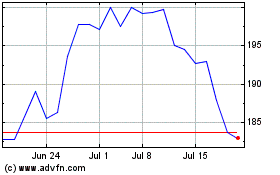Amazon, Google, Others Are Developing Private Air-Traffic Control for Drones
March 09 2018 - 2:45PM
Dow Jones News
By Andy Pasztor
BALTIMORE -- The commercial drone industry wants to create a
privately funded and operated air-traffic control network, separate
from the current federal system, to enable widespread operations at
low altitudes.
Plans to accelerate such efforts, spelled out at a conference
here this week, have the backing of companies like Amazon.com Inc.,
General Electric Co., Boeing Co. and Alphabet Inc.'s Google.
Proponents envision one day using automated cellular and web
applications to track and prevent collisions among swarms of small
unmanned aircraft flying a few hundred feet above the ground.
In conjunction with the National Aeronautics and Space
Administration, validation tests are slated over the next three
months at a handful of sites. The intent is to develop a "totally
different, new way of doing things," Parimal Kopardekar, NASA's
senior air-transport technologist who first suggested the idea of
an industry-devised solution, told approximately 1,000 attendees at
the conference.
The coming flights are intended to explore, among other factors,
how such a network would interact, when required, with the Federal
Aviation Administration's existing ground-based radars and human
controllers. Another major goal is to ensure swift and easy access
to data for law-enforcement agencies looking to identify errant,
suspicious or hostile drones.
Limited deployment will take at least two years, experts told
the conference, and significant engineering and policy hurdles
could push that goal out further. But even partial success in the
early stages would provide the foundation for an entirely new
airspace-management model.
The FAA -- which has relied on designing and deploying
custom-built technologies and often taken a decade or more to
belatedly roll them out -- wouldn't finance or run the anticipated
system for drones. The FAA would, however, retain some authority,
for example, to temporarily bar drones from certain areas if police
or medical-evacuation helicopters planned to pass through them.
For many of the engineering challenges, "the technology to do
this is basically off the shelf," including communication
principles and software repurposed from cellular phone companies,
according to Gur Kimchi, vice president of Amazon's Prime Air
organization, which is developing consumer package delivery. An
outspoken champion of low-altitude traffic solutions, Mr. Kimchi
said answers for some of the most vexing technical questions could
"take a year or two."
Company experts overseeing the air-traffic control initiative
will "observe the network," Mr. Kimchi said in his presentation; if
it works as designed, "they don't have to do anything" to resolve
conflicting flight paths. He said sensors developed for autonomous
automobiles could assist drone operators in detecting and avoiding
midair collisions.
James Burgess, co-lead of Project Wing, Google's proposed
customer delivery and drone integration program, told the
conference that given the drone industry's projected exponential
growth, "automation is a better answer for safety, as long as it's
done right."
Recreational operators have registered more than a million
unmanned aerial vehicles with the FAA, and many times that number
are expected to use domestic airspace by the end of the decade.
Some 70,000 U.S. drones are registered for commercial purposes.
According to industry estimates, roughly 1,500 operators, service
providers and related startups have swelled the U.S. industry's
ranks in recent years.
Among impediments to growth is the current lack of a reliable
and versatile means of traffic control. The FAA is deploying a
fledgling system that automatically allows drones to fly in unused
airspace close to airports. Much more study and technology
refinement is needed, however, before routine flights over
metropolitan areas or package delivery to homes can become a
reality.
The pace and scope of such advances are "really not an FAA
decision," according to Jay Merkle, a senior FAA program manager
and airspace planner. Any new approach to air-traffic control is a
decision for the entire drone community, he told the conference,
and success is bound to "depend on how well the industry will come
together."
Amazon and other companies have explicitly said industry will
shoulder the bulk of the costs.
To promote broad-based support, Amazon and other companies with
big ambitions in the drone world stress that their focus is on
finding answers to serve the widest possible range of operators.
The objective is to allow various types of drones equipped with
disparate communication links to talk to each other through
web-based applications or other compatible data-transfer
methods.
The model roughly parallels today's cellular systems, switch
seamlessly switch between towers and service providers depending on
the phone customer's location.
Performance data and safety incidents would be available to the
FAA and all others on the planned system.
Mr. Kimchi's stressed that whatever system is finally agreed on,
all operators must be able to benefit, because "airspace is only as
safe as the least safe element."
Write to Andy Pasztor at andy.pasztor@wsj.com
(END) Dow Jones Newswires
March 09, 2018 14:30 ET (19:30 GMT)
Copyright (c) 2018 Dow Jones & Company, Inc.
Amazon.com (NASDAQ:AMZN)
Historical Stock Chart
From Oct 2024 to Nov 2024

Amazon.com (NASDAQ:AMZN)
Historical Stock Chart
From Nov 2023 to Nov 2024
